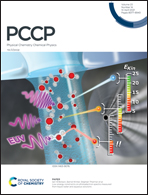Comparative density functional studies of pristine and doped bismuth ferrite polymorphs by GGA+U and meta-GGA SCAN+U†
Abstract
We analyzed the effect of nonmagnetic dopants Al, Ga, Sc, and In at the Fe-site on the phase stability, structural, and electronic properties of different bismuth ferrite (BiFeO3) polymorphs in the framework of density functional theory with the Hubbard U correction (DFT+U). We started our consideration from the determination of the magnitude of the U parameter. First, we calculated the structural, electronic, and magnetic properties of the rhombohedral R3c-G phase of BiFeO3 within the generalized gradient approximation (GGA) and strongly constrained and appropriately normed (SCAN) meta-GGA for different values of the U. Next, we compared these results with those obtained within the parameter-free hybrid functional. After determining the optimal values of the Hubbard U parameter we analyzed the total energies between the selected BiFeO3 polymorphs without and with dopants within both GGA+U and SCAN+U. For all dopants the concentration was 12.5% which was close to their solubility limit in BiFeO3 under ambient conditions. We found that none of these dopants led to the structural phase transition. However, DFT+U calculations revealed that the doping of BiFeO3 with Al and Ga reduced the energy barrier between R3c-G and Cm-C phases whereas for Sc and In the energy difference between both phases increased. For the orthorhombic phases the considered dopants do not affect the energy barrier between them and the rhombohedral phase. In addition, the ferroelectric polarization does not change after replacing the Fe atom by the dopant for the all considered BiFeO3 polymorphs.



 Please wait while we load your content...
Please wait while we load your content...